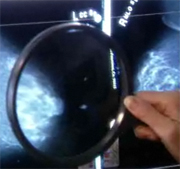
TUESDAY, May 1 (HealthDay News) — Women who receive a type of partial-breast radiation called brachytherapy may go on to have higher rates of breast cancer recurrence and side effects such as breast pain and infection than women receiving whole-breast radiation, a new study indicates.
Brachytherapy is an increasingly popular treatment option for women with early-stage breast cancer who have had a lumpectomy, which is surgery to remove just the part of the breast with the tumor.
The treatment, which involves inserting a radioactive pellet near the lumpectomy site, can be as short as one or two weeks, compared with the six-week course of whole-breast radiation, which directs beams of radiation at the entire breast.
In the current study, which was published in the May 2 issue of the Journal of the American Medical Association, researchers looked at the rates of mastectomy (surgical removal of the breast), survival and complications following brachytherapy and whole-breast radiation from national Medicare records of women aged 67 and older between 2003 and 2007.
Although brachytherapy patients experienced more complications and had more mastectomies, indicating their breast cancer came back, there was no difference in survival rates between the two groups five years after treatment.
“There is nothing in our study saying that a woman should not choose brachytherapy if they want the convenience, but I think it is helpful for women to think about the trade-offs, such as higher rates of mastectomy, postoperative complications and infections,” said study author Dr. Benjamin Smith, a radiologist at University of Texas M.D. Anderson Cancer Center, in Houston.
The study also found that the proportion of women diagnosed with invasive breast cancer who received brachytherapy increased from 3.5 percent in 2003 to 12.5 percent in 2007. This increase is probably due to a number of factors including patients wanting a shorter treatment course and surgeons driving the choice of the procedure, which, unlike other forms of radiation therapy, requires surgery, Smith explained.
“The wholesale push to brachytherapy outside of the protocol setting might be a little overenthusiastic,” Smith said. “Our study really emphasizes that we need to continue to enroll patients in trials to try to evaluate the technology.”
Brachytherapy is appropriate for women aged 60 and older with small tumors that have not spread outside of the breast, along with other indicators of less-advanced breast cancer, according to a 2009 American Society for Radiation Oncology statement written by a group of doctors that included Smith.
In younger women, breast cancer is generally thought to be more aggressive and data is lacking about the effectiveness of brachytherapy in this group, Smith said, adding that his practice only offers brachytherapy to younger women as part of clinical trials.
The current study included nearly 93,000 women aged 67 and older. About 7,000 women received brachytherapy, while almost 86,000 had whole-breast radiation.
The researchers found that about 4 percent of the women who received brachytherapy had to have a mastectomy within five years of their radiation treatment, compared with about 2 percent of the women in the whole-breast radiation group.
Despite mastectomy rates that were nearly twice as high in the brachytherapy group, “the overall rate of mastectomy was still quite low,” noted Dr. Sharad Goyal, a radiation oncologist at the University of Medicine & Dentistry of New Jersey.
Goyal added that it is not clear from this study whether mastectomies were actually due to breast cancer recurrence or complications such as fatty-tissue damage in the breast, which was more common in the brachytherapy group.
Overall, the rates of infection and other complications were about 28 percent among women who received brachytherapy, compared with 17 percent of women who received whole-breast radiation.
In particular, it is not surprising to see increased rates of infection within one year of treatment (16 percent of the brachytherapy group compared with 10 percent of the whole-breast radiation group) and breast pain within five years of treatment (14.5 percent of the brachytherapy group compared with 12 percent of the whole-breast radiation group), Smith said.
Brachytherapy involves “placing a catheter that will be in the patient’s breast for up to two weeks that could allow bacteria to enter the skin and cause an infection,” he explained.
There was no statistical difference between the five-year survival rate associated with brachytherapy (87.66 percent) and whole-breast radiation (87.04 percent). Breast cancer survival rates are not as much of a concern in this older population as improving the rate of breast preservation and decreasing the likelihood of local recurrence, study author Smith noted.
“The study by Smith and his colleagues will not change how I practice brachytherapy,” Goyal said. “I will inform my patients of what the study found and that there was a higher rate of mastectomy with brachytherapy, but that it is not clear if it was due to tumor recurrence.”
For some patients, a greater possibility of having a second procedure and a catheter for brachytherapy are enough to make them steer away from this option, Goyal said.
In this case, another form of partial radiation called external beam radiation, which is more common than brachytherapy and involves an external radiation source directed more locally at the lumpectomy area, can provide similar results as brachytherapy, Goyal added.
Brachytherapy might be a more attractive option now than it was between 2003 and 2007, according to Goyal. “I presume that side effects will be lower because catheters and imaging modalities have improved.”
However, Smith said he doubts that these improvements will bring mastectomy rates down following brachytherapy because all of the catheters aim to deliver radiation just to a 1-centimeter ring around the lumpectomy site.
While the current study looked at Medicare records of women who had already been treated, “the definitive trials [that follow women] comparing brachytherapy to whole-breast irradiation are still ongoing,” but they are years away from giving definitive results, Smith said.
More information
To learn more about breast cancer treatments, visit the American Cancer Society.

